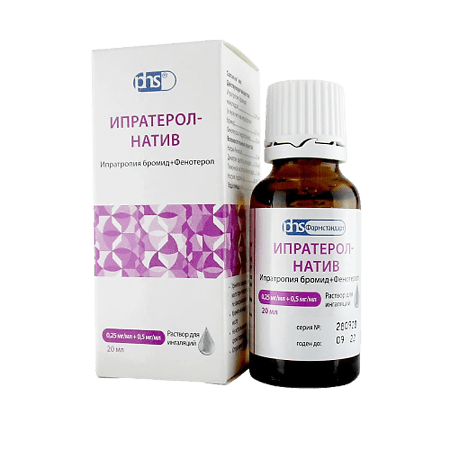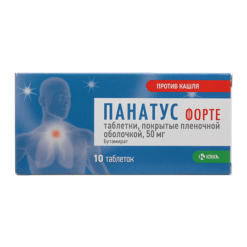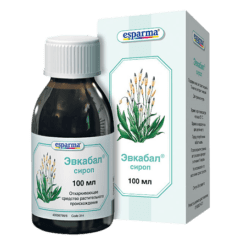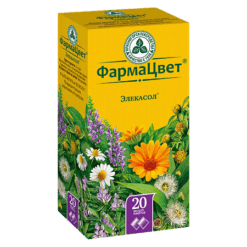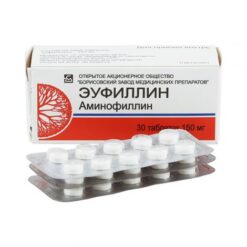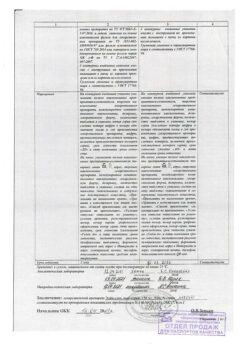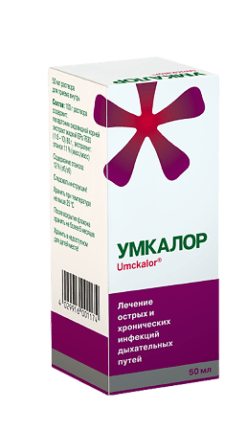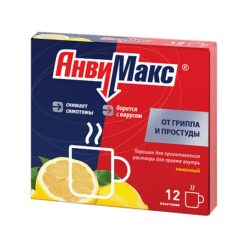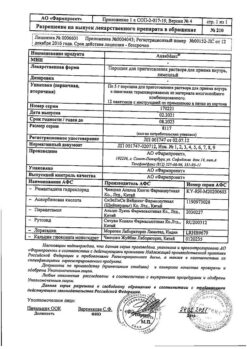No products in the cart.
Ipraterol-Native, 0.25 mg/ml+0.5 mg/ml 20 ml
€7.01 €5.84
Out of stock
(E-mail when Stock is available)
Description
Pharmacotherapeutic group: combined bronchodilator (beta2-adrenomimetic selective + m-cholinoblocker).
ATX code: R03AL01
Pharmacological properties
Pharmacodynamics
/p>
The drug Ipraterol-ative contains two components that have bronchodilator activity: ipratropium bromide, a m-cholinoblocker, and fenoterol, a β2-adrenomimetic.
The bronchodilation by inhaled administration of ipratropium bromide is due primarily to local rather than systemic anticholinergic action.
Ipratropium bromide is a quaternary ammonium derivative with anticholinergic (parasympatholytic) properties. Ipratropium bromide inhibits vagus nerve reflexes by counteracting the effects of acetylcholine, a mediator released from the vagus nerve endings. Anticholinergic agents prevent the increased intracellular concentration of calcium ions that occurs due to the interaction of acetylcholine with muscarinic receptors of bronchial smooth muscle. The release of calcium ions is mediated by a system of secondary mediators, which include inositol triphosphate (ITP) and diacylglycerol (DAG).
In patients with bronchospasm associated with chronic obstructive pulmonary disease (chronic bronchitis and pulmonary emphysema), significant improvements in lung function (increased forced expiratory volume in 1 second (PEF1) and peak expiratory flow (PEF) by 15% or more) are observed within 15 minutes, the maximum effect is achieved in 1-2 hours and continues in most patients up to 6 hours after administration.
Ipratropium bromide has no adverse effect on airway mucus secretion, mucociliary clearance and gas exchange.
Phenoterol selectively stimulates β2 adrenoreceptors at the therapeutic dose. Stimulation of β1-adrenoreceptors activates adenylate cyclase through stimulation of GS-protein. Stimulation of β1-adrenoreceptors occurs at high doses. Fenoterol relaxes the smooth muscles of the bronchi and vessels and counteracts the development of bronchospastic reactions due to the effects of histamine, methacholine, cold air and allergens (immediate-type hypersensitivity reactions). Immediately after use, fenoterol blocks the release of inflammatory mediators and bronchoconstriction from mast cells. In addition, when using fenoterol in doses of 0.6 mg, an increase in mucociliary clearance is noted.
The β2-adrenergic effects of the drug on cardiac activity, such as increased heart rate and force, are due to the vascular action of fenoterol, the stimulation of β2 adrenoreceptors of the heart, and, when using doses greater than therapeutic, by stimulation of β1-adrenoreceptors.
As with other β-adrenergic drugs, prolongation of the QT intervalc when using high doses is noted. When fenoterol was used with metered-dose aerosol inhalers (MDIs), this effect was inconsistent and was noted when doses higher than recommended were used. However, after using fenoterol with a nebulizer (standard-dose inhalation solution in vials), the systemic effect may be higher than when using the drug with a DAI in the recommended doses. The clinical significance of these observations has not been established.
Tremor is the most common undesirable effect when using β1-adrenoreceptor agonists. In contrast to effects on bronchial smooth muscle, tolerance may develop to the systemic effects of β1-adrenoreceptor agonists, but the clinical significance of this phenomenon has not been identified.
When using ipratropium bromide and fenoterol together, the bronchodilator effect is achieved by acting on different pharmacological targets. The above active substances complement each other, as a result the antispasmodic effect on the bronchial muscles increases and provides greater therapeutic latitude in bronchopulmonary diseases accompanied by airway constriction. The complementary action is such that a lower dose of the β-adrenergic component is required to achieve the desired effect, which allows for individual selection of the effective dose with almost no side effects of ipraterol-nativ.
In acute bronchoconstriction the effect of ipraterol-nativ develops quickly, allowing its use in acute attacks of bronchospasm.
Pharmacokinetics
The therapeutic effect of the combination of ipratropium bromide and phenoterol results from its local action in the airways. The development of bronchodilation is not directly proportional to the pharmacokinetic indices of the active substances.
After inhalation, 10-39% of the administered drug dose usually enters the lungs (depending on the dosage form and method of inhalation). The remainder of the dose is deposited in the mouthpiece, oral cavity and oropharynx. The portion of the dose deposited in the oropharynx is swallowed and enters the gastrointestinal tract.
The portion of the dose that reaches the lungs quickly reaches the systemic bloodstream (within minutes).
There is no evidence that the pharmacokinetics of the combined product are different from those of each individual component.
Phenoterol
The ingested portion of the dose is metabolized to sulfate conjugates. Absolute bioavailability when ingested is low (about 1.5%).
After intravenous administration, free and conjugated fenoterol make up 15% and 27% of the administered dose, respectively, in the 24-hour urinalysis. Total systemic bioavailability of the inhaled dose of fenoterol is estimated at 7%.
Pharmacokinetic parameters describing the distribution of fenoterol are calculated from plasma concentrations after intravenous administration. After intravenous administration, plasma concentration-time profiles can be described by a 3-chamber pharmacokinetic model according to which the half-life is approximately 3 hours. In this 3-chamber model, the apparent volume of distribution of fenoterol at equilibrium (Vdss) is approximately 189L (≈2.7 L/kg).
About 40% of phenoterol binds to plasma proteins.
Preclinical studies have shown that fenoterol and its metabolites do not penetrate the blood-brain barrier. Total clearance of fenoterol is 1.8 l/min, renal clearance – 0.27 l/min. Total renal excretion (over 2 days) of the isotope-labeled dose (including the parent compound and all matabolites) was 65% after intravenous administration. The total isotope-labeled dose excreted through the intestine was 14.8% after intravenous administration and 40.2% for 48 hours after ingestion. The total isotope-labeled dose excreted through the kidneys was about 39% after oral administration.
Ipratropium bromide
The total renal excretion (over 24 hours) of the parent compound is approximately 46% of the intravenous dose, less than 1% of the oral dose, and approximately 3-13% of the inhaled dose of the drug. Based on these data, the total systemic bioavailability of ipratropium bromide administered orally and inhaled was calculated to be 2% and 7-28%, respectively. Thus, the effect of the ingested portion of ipratropium bromide on systemic exposure is negligible.
Pharmacological parameters describing the distribution of ipratropium bromide were calculated based on its plasma concentrations after intravenous administration. A rapid biphasic decrease in plasma concentrations was observed. The apparent volume of distribution at equilibrium (Vdss) was approximately 176 L (≈2.4 L/kg).
Ipratropium bromide binds to plasma proteins to a minimal extent (less than 20%).
Preclinical studies have shown that ipratropium bromide, which is a quaternary ammonium derivative, does not penetrate the blood-brain barrier. The elimination half-life in the terminal phase is approximately 1.6 hours.
The total clearance of ipratropium bromide is 2.3 l/min and renal clearance is 0.9 l/min. After intravenous administration, approximately 60% of the dose is metabolized by oxidation, mainly in the liver.
The total renal excretion (over 6 days) of the isotope-labeled dose (including the parent compound and all metabolites) was 72.1% after intravenous administration, 9.3% after oral administration, and 3.2% after inhalation. The total isotope-labeled dose excreted through the intestine was 6.3% after intravenous administration, 88.5% after ingestion, and 64.9% after inhalation. Thus, the isotope-labeled dose after intravenous administration is mainly excreted through the kidneys. The elimination half-life of the parent compound and metabolites is 3.6 hours. The major urinary excreted metabolites bind weakly to muscarinic receptors and are considered inactive.
Indications
Indications
Active ingredient
Active ingredient
Composition
Composition
Active ingredients:
Ipratropium bromide monohydrate 0.261 mg
(in terms of ipratropium bromide 0.25 mg)
/p>
Phenoterol hydrobromide 0.5 mg
Excipients:
Sodium benzoate 0.5 mg
Dinatrium edetate dihydrate 0.554 mg
Citric acid monohydrate 1.5 mg
Sodium hydroxide to pH 3.2
Purified water to 1.0 ml
How to take, the dosage
How to take, the dosage
Inhaled.
The treatment must be carried out under medical supervision (e.g. in a hospital setting). Treatment at home is only possible after consultation with a physician in cases where a low-dose, rapid-acting β-agonist is not sufficiently effective. An inhalation solution may also be recommended for patients when an aerosol for inhalation cannot be used or when higher doses are necessary. The dose should be adjusted individually, depending on the severity of the attack.
Treatment should usually be started with the lowest recommended dose and discontinued when sufficient symptom reduction has been achieved.
The following doses are recommended:
In adults (including elderly and elderly patients) and adolescents over 12 years
Interaction
Interaction
Long-term concomitant use of Ipraterol-Nativ with other anticholinergic drugs is not recommended due to lack of data. β-adrenomimetic and anticholinergic agents, xanthine derivatives (e.g., theophylline) may increase the bronchodilator effect of the drug.
The concomitant use of other β-adrenomimetic, acetylcholinergic drugs or xanthine derivatives (e.g., theophylline) may increase the side effects.
The hypokalemia associated with the use of β-adrenomimetics may be exacerbated by simultaneous administration of xanthine derivatives, cranocorticosteroids and diuretics. This fact should be given special attention when treating patients with severe forms of obstructive airway disease.
Hypokalemia may increase the risk of arrhythmias in patients receiving digoxin. In addition, hypoxia may increase the negative effect of hypokalemia on heart rhythm. In such cases, monitoring of serum potassium concentration is recommended.
The β2-adrenergic drugs should be used with caution in patients who have received monoamine oxidase inhibitors and tricyclic antidepressants, because these drugs can potentiate the effects of β-adrenergic drugs.
Inhalation of halogenated hydrocarbon anesthetics such as halothane, trichloroethylene, or enflurane may increase the effects of β-adrenergic agents.
The co-administration of Ipraterol-Nativ with cromoglycic acid and/or glucocorticosteroids increases the effectiveness of therapy.
Special Instructions
Special Instructions
Dyspnea
In case of sudden rapid onset of dyspnea (difficulty in breathing), consult a physician immediately.
Hypersensitivity
After use of Ipraterol-Nativ may cause immediate hypersensitivity reactions, the signs of which in rare cases may be: urticaria, angioedema, rash, bronchospasm, oropharyngeal edema, anaphylactic shock.
Paradoxical bronchospasm
Ipraterol-nativ, like other inhaled medicines, may cause paradoxical bronchospasm, which may be life-threatening. If paradoxical bronchospasm develops, Ipraterol-Nativ should be discontinued immediately and alternative therapy should be used.
Long-term use
In patients with bronchial asthma, Ipraterol-Nativ should be used only as needed; in patients with mild COPD, symptomatic treatment may be preferable to regular use.
In patients with bronchial asthma, it should be remembered that anti-inflammatory therapy should be given or intensified to control airway inflammation and the course of the disease.
The regular use of increasing doses of drugs containing β2-adrenomimetics, such as ipraterol-nativ, to relieve bronchial obstruction can cause uncontrolled worsening of the disease course. If bronchial obstruction worsens, increasing the dose of β2-adrenomimetics, including Ipraterol Nativ, beyond the recommended dose for an extended period of time is not only unreasonable, but also dangerous. To prevent a life-threatening worsening of the course of the disease, a review of the patient’s treatment plan and adequate anti-inflammatory therapy with inhaled glucocorticosteroids should be considered.
Other sympathomimetic bronchodilators should be administered concomitantly with Ipraterol-Nativ under medical supervision only.
Gastrointestinal disorders
In patients with a history of cystic fibrosis, gastrointestinal motility disorders are possible.
Visual disorders
Contact of the drug to the eyes should be avoided.
The drug ipraterol-nativ should be used with caution in patients predisposed to closed-angle glaucoma. There have been isolated reports of ocular complications (e.g., increased intraocular pressure, mydriasis, closed-angle glaucoma, eye pain) developing when inhaled ipratropium bromide (or ipratropium bromide in combination with β2-adrenomimetics) enters the eye. Symptoms of acute closed-angle glaucoma may include pain or discomfort in the eyes, blurred vision, haloing around objects, and colored spots in front of the eyes, combined with corneal edema and red eyes due to conjunctival vascular injection. If any combination of these symptoms develops, the use of eye drops that reduce intraocular pressure and immediate consultation with a specialist are indicated. Patients should be instructed on the proper use of Ipraterol-Nativ inhaled solution. To prevent eye contact with the solution, it is recommended that the solution used with the nebulizer be inhaled through a mouthpiece. If a mouthpiece is not available, a mask that fits snugly over the face should be used. Patients with a predisposition to glaucoma should be especially careful to protect their eyes.
Systemic effects
. In conditions such as recent myocardial infarction, insufficiently controlled diabetes mellitus, severe organic heart and vascular disease, hyperthyroidism, pheochromocytoma, urinary tract obstruction (such as in prostatic hyperplasia or bladder cervical obstruction), Ipraterol-Native should be used only after careful risk/benefit assessment, especially when using doses higher than recommended.
Impact on the cardiovascular system
In post-marketing studies, there have been rare cases of myocardial ischemia when taking β2-adrenomimetics. Patients with concomitant serious heart disease (e.g. coronary heart disease, arrhythmias, or severe heart failure) receiving ipraterol-nativ should be warned to consult a physician if heart pain or other symptoms suggestive of worsening heart disease occur. You should pay attention to symptoms such as shortness of breath and chest pain, as they may be of cardiac or pulmonary etiology.
Hypokalemia
Hypokalemia may occur with the use of β2-adrenomimetics (see section on Overdose).
In athletes, the use of ipraterol-nativ may lead to positive doping tests due to its presence in phenoterol.
Auxiliary substances
The drug contains the stabilizer dinatrium edetate dihydrate. During inhalation, this component may cause bronchospasm in sensitive patients with airway hyperresponsiveness.
Influence on ability to drive and operate vehicles
There have been no studies of the effect of the combined product containing ipratropium bromide and fenoterol on the ability to drive and operate vehicles. Since during the use of the drug such adverse reactions as dizziness, tremor, eye accommodation disorder, mydriasis and blurred vision may occur, caution should be exercised when driving vehicles and operating machinery as well as when engaged in other potentially dangerous activities that require high concentration and rapid psychomotor reactions. And in case of the specified adverse reactions one should refrain from these activities.
Contraindications
Contraindications
– Hypersensitivity to ipratropium bromide, fenoterol, as well as to other atropine-like substances and excipients included in the drug.
– Hypertrophic obstructive cardiomyopathy.
– Tachyarrhythmia.
– First trimester of pregnancy.
With caution
. Closed-angle glaucoma, arterial hypertension, insufficiently controlled diabetes mellitus, recent myocardial infarction, severe organic heart and vascular disease, coronary heart disease, hyperthyroidism, pheochromocytoma, urinary obstruction, cystic fibrosis, II and III trimesters of pregnancy, breastfeeding period, children under 6 years old.
Side effects
Side effects
Many of the listed undesired effects may be a consequence of the cholinergic and β-adrenergic properties of the drug. Ipraterol-nativ, like any inhaled therapy, may cause local irritation. Adverse reactions of the drug have been determined based on data obtained in clinical studies and pharmacovigilance of the drug.
The most common adverse effects reported in clinical trials were cough, dry mouth, headache, tremor, pharyngitis, nausea, dizziness, dysphonia, tachycardia, palpitations, vomiting, increased systolic blood pressure, and nervousness.
Frequency determination of adverse reactions: very frequently ( ⩾ 1/10); frequently ( ⩾ 1/100, < 1/10); infrequently ( ⩾ 1/1000, < 1/100); rarely ( ⩾ 1/10000, < 1/1000); very rarely (< 1/10000); frequency unknown (frequency cannot be estimated from available data).
Immune system disorders: rare* – anaphylactic reaction, hypersensitivity.
Metabolic and nutrition disorders: rare* – hypokalemia; very rare – increase in serum glucose.
Mental disorders: infrequent – nervousness; very rarely – agitation, mental disorders.
Nervous system disorders: infrequent – headache, tremor, dizziness; frequent unknown – hyperactivity.
Visual disorders: rarely* – glaucoma, increased intraocular pressure, accommodation disorders, mydriasis, blurred vision, eye pain, corneal edema, conjunctival hyperemia, appearance of a halo around objects.
Cardiac disorders: infrequent – tachycardia, palpitations; seldom – arrhythmia, atrial fibrillation, supraventricular tachycardia*, myocardial ischemia*.
Disorders of the respiratory organs, chest and mediastinum: frequently – cough; frequently – pharyngitis, dysphonia; seldom – bronchospasm, pharyngeal irritation, pharyngeal edema, laryngospasm*, paradoxical bronchospasm*, dry throat*.
Gastrointestinal tract disorders: infrequent- vomiting, nausea, dry mouth; rare- stomatitis, glossitis, gastrointestinal motility disorders, diarrhea, constipation*, oral edema*, heartburn.
Skin and subcutaneous tissue disorders: rarely – urticaria, pruritus, angioedema*, hyperhidrosis*, rash, petechiae.
Muscular and connective tissue disorders: rarely – muscle weakness, muscle spasm, myalgia.
Repnal and urinary tract disorders: rare – urinary retention.
Laboratory and instrumental data: infrequent increased systolic blood pressure; rarely increased diastolic blood pressure.
*These adverse reactions have not been identified in clinical studies. Estimated based on the upper limit of the 95% confidence interval calculated for the general patient population.
Overdose
Overdose
Symptoms
The symptoms of overdose are usually associated with the action of fenoterol. Symptoms due to overstimulation of β-adrenoreceptors may occur. The most probable are tachycardia, palpitations , tremor, high or low blood pressure, increased difference between systolic and diastolic blood pressure, angina pectoris, arrhythmia and a feeling of “flushes”. Metabolic acidosis and hypokalemia were also observed.
The symptoms of ipratropium bromide overdose (such as dry mouth, impaired eye accommodation), given the wide therapeutic range of the drug and the topical route of administration, are usually mild and transient.
Treatment
The drug should be discontinued.
The data of blood acid-base balance monitoring should be taken into account. Sedatives, tranquilizers are indicated, in severe cases – intensive therapy.
As a specific antidote, β-adrenoblockers, preferably selective β1-adrenoblockers may be used. However, one should keep in mind the possible increase in bronchial obstruction under the influence of β-adrenoblockers and carefully select the dose for patients with bronchial asthma or chronic obstructive pulmonary disease (COPD), due to the risk of severe bronchospasm, which can be fatal.
Pregnancy use
Pregnancy use
Pregnancy
Ipraterol Nativ is contraindicated in the first trimester of pregnancy.
Existing clinical experience has shown that phenoterol and ipratropium bromide have no adverse effect on pregnancy. However, the usual precautions (II and III trimesters) should be observed when using these drugs during pregnancy. The inhibitory effect of fenoterol on uterine contractility should be taken into account.
Breastfeeding period
Preclinical studies have shown that fenoterol may penetrate into breast milk. No such data have been obtained for ipratropium bromide. Significant effects of ipratropium bromide on the infant, especially when used in aerosol form, are unlikely. Nevertheless, given the ability of many drugs to penetrate into breast milk, caution should be exercised when prescribing Ipraterol-Nativ to breastfeeding women.
Fertility
There are no clinical data on the effect of fenoterol, ipratropium bromide or their combination on fertility. Preclinical studies have shown no effect of ipratropium bromide and fenoterol on fertility.
Similarities
Similarities
Additional information
| Shelf life | 2 years. Do not use after the expiration date stated on the package. |
|---|---|
| Conditions of storage | In a light-protected place at a temperature not exceeding 25 °C. Do not freeze. Keep out of reach of children. |
| Manufacturer | Pharmstandard-Leksredstva, Russia |
| Medication form | solution for inhalation |
| Brand | Pharmstandard-Leksredstva |
Related products
Buy Ipraterol-Native, 0.25 mg/ml+0.5 mg/ml 20 ml with delivery to USA, UK, Europe and over 120 other countries.

